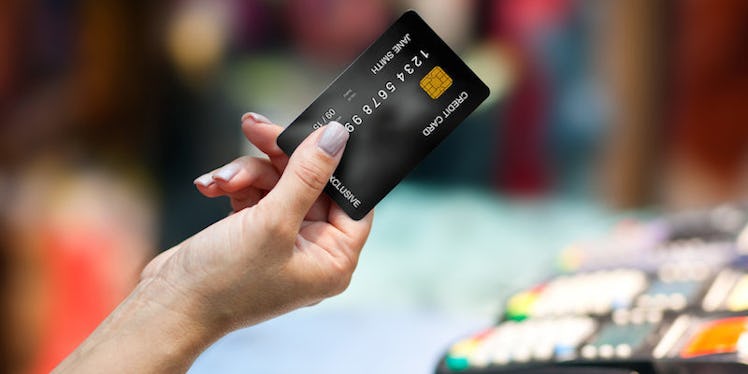
7 Ways To Pay Off Credit Card Debt Without Totally Changing Your Lifestyle
Debt has a grip on many American households, creeping into the daily ebb and flow of American life. In fact, in 2015, the average American household credit card debt was $15,762. The marketing strategy effects of credit card companies have become so pervasive that over 70 percent of Americans have at least one credit card.
To lure potential consumers into signing up for new credit cards companies flaunt rewards, points and cash back programs. Once consumers begin using their credit cards, the credit card companies capitalize on American consumerism and the fallibility of human behavior.
Missing monthly payments, making costly impulse purchases and spending more are consumer behaviors that credit card companies count on to snare consumers. These habits lead to the cycle of credit card entanglement, and the credit card debt spiral begins. It is not until the heady elixir of easy money wears off that most people begin facing the reality of their predicament.
Fortunately for you, hope is not lost. You have the ability to rid yourself of credit card debt fast. Here are seven steps you can take to break the cycle and pay back your credit card debit:
1. Acknowledge your credit card debt.
As with most interventions, the first step toward behavioral change is acknowledgement that a problem exists. Your debt comes from a pattern of overspending. Take time for self-reflection to examine how you came to your current financial position.
What purchases led you to your credit card use? Did you use your credit cards at particular times that later caused you problems? Construct a full inventory of your purchasing habits and analyze your consumption.
2. List your credit card debts in ascending order.
It's time to pull out all of your credit cards and lay them down on a desk. Begin sorting them by balance, starting with the smallest balance and working your way toward the largest balance. This process helps you visualize how many cards you are actually using and gives you a keen sense of what you are up against.
Chances are, if you have one credit card, you may have multiple cards. In fact, according to the Federal Reserve Bank of Boston, people who had credit cards in 2012 tended to have about four credit cards.
The smallest balance on your list is what you are going to attack and eliminate first. Write down the smallest credit card balance on a piece of paper and attach it to you refrigerator door. Look at it over and over again. This is now your first target.
3. Create a budget.
Now that you know what credit card to pay off first, you can start building a budget. Begin by analyzing your monthly income and expenses. List out all of your fixed expenses that aren't going to change from month to month (rent, car payments, insurance, etc). Once you have your fixed costs listed, proceed to list your monthly variable costs. Variable costs are costs that fluctuate based on level of activity (going out to eat, drinks, clothes, etc).
After you have subtracted all of your expenses from your income, your margin of error is revealed. Let's say you have $1,000 left over after you subtract expenses from income. That $1,000 should go toward paying off your lowest credit card balance. (Remember it's the credit card balance you hung on your refrigerator door).
Creating your budget to meet your current debt repayment needs may take some work. Luckily, there are only two ways to improve your budget. Either increase your earnings, or cut your costs.
4. Snowball your success.
One of the most important aspects of getting rid of debt is behavioral modification. The positive psychological impact of gaining incremental success by paying down your smallest debt first is crucial. (Just ask Dave Ramsey.)
Conventional wisdom will tell you otherwise: Pay off your debts beginning with the highest interest rates first. In fact, whole debt repayment businesses are built off of this faulty logic. While this approach makes economic sense, paying off debt is not always about the best economic approach. This notion was proven by researchers at Northwestern University's Kellogg School of Management. They found that consumers who tackle small balances first are more likely to eliminate their overall debt.
5. Pay with cash.
Once you begin the positive cycle of paying off your smaller credit card balances, you should next focus on how you are going to handle your day-to-day purchases. Because you fell prey to the friction-less form of credit card payment, you should start using cash for daily transactions.
There are several benefits to paying with cash. It gives you a tangible and visible pulse on how well you are sticking to your budget. Additionally, making payments with cash can cause you to pause and contemplate the magnitude of each purchase.
6. Celebrate your wins.
As with any big accomplishment, it is important to acknowledge your small wins along the way. Each time you pay off a credit card balance, celebrate your success (using the cash from step five), and give yourself a reward. As the credit card balances get larger, the rewards will become less frequent. But, the rewards become that much sweeter as you approach your final payment.
7. Write about your success.
As you develop new spending habits, it will be important to reflect on your day. The process of journaling will allow you to prime yourself for successful habits and cultivate a sense of gratitude for the things that you do have. Reflecting and internalizing your daily financial wins will improve your success rate. This daily routine will help you capture the daily ease of credit card spending that you are fighting to contain.
This article was originally published on Launch Your Finances.